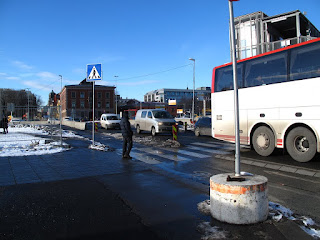The pedestrian and automobile routes to, around, and from this current construction site continues to perplex Oslo residents. People are rerouted on a daily basis, with a variety of signage that describes the circuitous at best detours. I found myself somewhat amused at the physical effort currently required of a pedestrian to make a simple loop around the new neighborhood. It all began with the need to cross a road, which is no longer just a road but a multi-lane rotary.
And then the solution for it..
 |
| The ramp and bridge to the left crosses the rotary directly to the front. |
It seems that we've gone from ramping cars out of the way overhead in the traffic machine, to this solution I am naming the human machine - ramping pedestrians up and over traffic. Of course the resulting view gives an interesting perspective on the otherwise un-crossable road.
Eventually on the other side I came to the site of the old Bispelokket - where not much of it is still intact.
Behind the Opera this and other construction has taken over for the time being. Pedestrians who are typically put first on Norwegian roadways are channeled between concrete barriers and reminded to watch for turning traffic.
 |
| The sign here says "Careful! Does the car see you?" |
 |
| Traffic to be crossed between the Opera plaza and the next pedestrian bridge. |
 |
| View over old Bispelokket site from Opera's pedestrian bridge. |
These aspects of planning and engineering the movement of traffic and humans in machines brings the 1920s German movie Metropolis to mind. There is something particular dystopian about development, especially while it is underway. It is difficult to look at this site today and imagine that in the future it is to be a progressive pedestrian friendly neighborhood that will magically connect the new buildings along the fjord to the existing urban fabric behind the train tracks.
 |
| The plaza in front of the Opera currently stands as a pedestrian friendly island amidst chaos. |
More photos from this site here.



